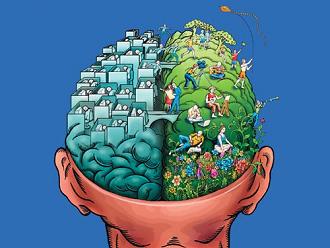 When I was growing up, my dad liked to talk about how Americans and Asians thought differently. He always referred to it as right brain versus left brain thinking. As an immigrant he of course had Asian thinking, while his three children who grew up in America, had American thinking. As a scholar, my dad had even gotten to the point of writing a reflective book about it, but never got it published before he passed away.
When I was growing up, my dad liked to talk about how Americans and Asians thought differently. He always referred to it as right brain versus left brain thinking. As an immigrant he of course had Asian thinking, while his three children who grew up in America, had American thinking. As a scholar, my dad had even gotten to the point of writing a reflective book about it, but never got it published before he passed away.
Apparently, scientists have also been pursuing this as a real difference between the ways Asian (Eastern) brains and Western brains process information. A recent article discusses this phenomenon and started by discussing researcher Richard Nisbett from the University of Michigan, Ann Arbor, and a study he did in 2001. A short explanation from the article:
East Asians tending to group things according to how they relate to each other and Americans tending to rely on shared features. When shown pictures of a chicken, a cow and some grass, and asked to decide which two objects belong most closely together, for example, most American kids choose the chicken and cow, since they are both animals, while Taiwanese children tend to group the cow and the grass together because one eats the other …
Westerners appear to perceive the world in an analytic way, narrowing their focus onto prominent objects, lumping them into categories and examining them through logic. Easterners take a more holistic view: they are more likely to consider an object’s context and analyse it through its changing relationships with its environment.
This sets an interesting stage, one that many of us already assume as true, which is that Asians think differently and process differently than Westerners. But what’s interesting is the same article goes on to disprove this theory, saying we’re really more alike than we’re different. That our context actually affects the way we think. Asians think holistically because we tend to be in group settings, but Westerners tend to be individualistic. The article then discusses a study using “priming”, making an Asian test subject think about individualistic tasks (e.g. playing singles tennis), and found that afterwards, the person thought and processed with a more individualistic style, showing any person can think either way.
Here’s the conclusion:
Clearly, the dichotomy between holistic eastern and analytical western thinking is more blurred than the stereotypes suggest. … We all flip between different modes of thought depending on social context… What is clear is that the minds of east Asians, Americans or any other group are not wired differently. We are all capable of both analytic and holistic thought.
So maybe we weren’t as different in the way we think as my dad believed. And that’s also what’s been going through my mind these past few months, reflecting on the loss of both my parents. As much as I had conflicts with my dad, as I get older, I find myself doing things I know he would do, thinking about things the way he would. I know I’m not turning into my dad, and I have some comfort in knowing we’re not as different as I once thought we were.
- Excited
- Fascinated
- Amused
- Disgusted
- Sad
- Angry








